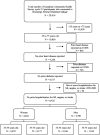Associations of free sugars from solid and liquid sources with cardiovascular disease: a retrospective cohort analysis
- PMID: 37095459
- PMCID: PMC10124057
- DOI: 10.1186/s12889-023-15600-3
Associations of free sugars from solid and liquid sources with cardiovascular disease: a retrospective cohort analysis
Abstract
Background: The World Health Organization recommends a 10% total energy (TE%) limit for free sugars (i.e., added sugars and naturally occurring sugars in fruit juice, honey, and syrups) based on evidence linking higher intakes with overweight and dental caries. Evidence for cardiovascular disease (CVD) is limited. Impacts may differ by sex, age group, and solid vs. liquid sources; liquids may stimulate more adverse CVD profiles (due to their rapid absorption in the body along along with triggering less satiety). We examined associations of consuming total free sugars ≥ 10 TE% with CVD within four sex and age-defined groups. Given roughly equal free sugar intakes from solid and liquid sources, we also evaluated source-specific associations of free sugars ≥ 5 TE% thresholds.
Methods: In this retrospective cohort study, we estimated free sugars from 24-h dietary recall (Canadian Community Health Survey, 2004-2005) in relationship to nonfatal and fatal CVD (Discharge Abstract and Canadian Mortality Databases, 2004-2017; International Disease Classification-10 codes for ischemic heart disease and stroke) through multivariable Cox proportional hazards models adjusted for overweight/obesity, health behaviours, dietary factors, and food insecurity. We conducted analyses in separate models for men 55 to 75 years, women 55 to 75 years, men 35 to 55 years, and women 35 to 55 years. We dichotomized total free sugars at 10 TE% and source-specific free sugars at 5 TE%.
Results: Men 55 to 75 years of age had 34% higher CVD hazards with intakes of free sugars from solid sources ≥ 5 TE% vs. below (adjusted HR 1.34, 95% CI 1.05- 1.70). The other three age and sex-specific groups did not demonstrate conclusive associations with CVD.
Conclusions: Our findings suggest that from a CVD prevention standpoint in men 55 to 75 years of age, there may be benefits from consuming less than 5 TE% as free sugars from solid sources.
Keywords: Added sugars; Heart disease; Intake limits; Stroke.
© 2023. The Author(s).
Conflict of interest statement
The authors declare no competing interests.
Figures

Similar articles
-
Associations of overweight and gestational diabetes mellitus with free sugars from solid and liquid sources: cross-sectional and nested case-control analyses.BMC Public Health. 2021 Oct 23;21(1):1923. doi: 10.1186/s12889-021-12000-3. BMC Public Health. 2021. PMID: 34688275 Free PMC article.
-
Associations between added sugar (solid vs. liquid) intakes, diet quality, and adiposity indicators in Canadian children.Appl Physiol Nutr Metab. 2015 Aug;40(8):835-41. doi: 10.1139/apnm-2014-0447. Appl Physiol Nutr Metab. 2015. PMID: 26244601
-
Added sugar intake and its forms and sources in relation to risk of non-alcoholic fatty liver disease: results from the Tianjin Chronic Low-grade Systemic Inflammation and Health cohort study.Br J Nutr. 2023 Jun 28;129(12):2094-2101. doi: 10.1017/S000711452200277X. Epub 2022 Sep 26. Br J Nutr. 2023. PMID: 36156191
-
Is too much sugar bitter? The impacts of sugars on health.Community Dent Health. 2024 Aug 30;41(3):195-201. doi: 10.1922/CDH_00108Yusuf07. Community Dent Health. 2024. PMID: 39105564 Review.
-
Sugar in Infants, Children and Adolescents: A Position Paper of the European Society for Paediatric Gastroenterology, Hepatology and Nutrition Committee on Nutrition.J Pediatr Gastroenterol Nutr. 2017 Dec;65(6):681-696. doi: 10.1097/MPG.0000000000001733. J Pediatr Gastroenterol Nutr. 2017. PMID: 28922262 Review.
Cited by
-
Patterns of Gestational Hypertension or Preeclampsia Across 2 Pregnancies in Relationship to Chronic Hypertension Development: A Retrospective Cohort Study.J Am Heart Assoc. 2024 Jul 2;13(13):e034777. doi: 10.1161/JAHA.124.034777. Epub 2024 Jun 21. J Am Heart Assoc. 2024. PMID: 38904245 Free PMC article.
-
Association of sugar intake from different sources with cardiovascular disease incidence in the prospective cohort of UK Biobank participants.Nutr J. 2024 Feb 22;23(1):22. doi: 10.1186/s12937-024-00926-4. Nutr J. 2024. PMID: 38383449 Free PMC article.
-
Incident Diabetes in Women With Patterns of Gestational Diabetes Occurrences Across 2 Pregnancies.JAMA Netw Open. 2024 May 1;7(5):e2410279. doi: 10.1001/jamanetworkopen.2024.10279. JAMA Netw Open. 2024. PMID: 38722629 Free PMC article.
References
-
- WHO Guidelines Approved by the Guidelines Review Committee . Guideline: Sugars Intake for Adults and Children. Geneva: World Health Organization Copyright © World Health Organization; 2015. p. 2015.
-
- Carbohydrates and Health . The Stationery Office (TSO) 2015.
Publication types
MeSH terms
Substances
LinkOut - more resources
Full Text Sources
Medical

